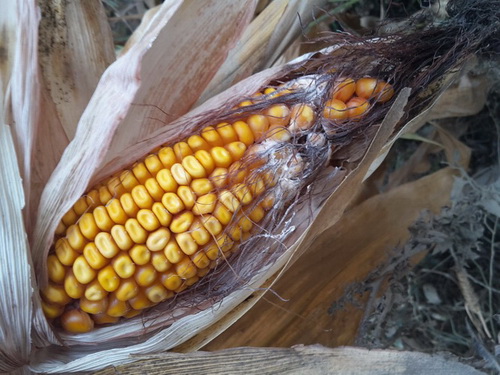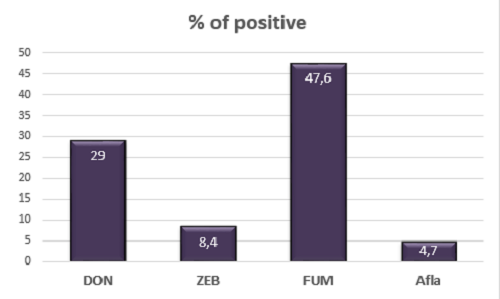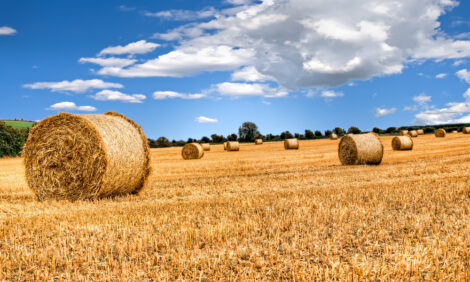



Nutriad Concludes 2016 Spain Maize Mycotoxin Survey
Mycotoxins are secondary metabolites produced by filamentous fungi that cause a toxic response (mycotoxicosis) when ingested by farm and companion animals.Fusarium, Aspergillus, and Penicillium are the most abundant moulds that produce these toxins. They contaminate human foods and animal feeds through fungal growth prior to and during harvest, or during (improper) storage (Bhatnagar et al., 2004).

Picture 1: Maize harvested in central Europe 2016
©Copyright: Radka Borutova, NUTRIAD International
The 2016 NUTRIAD Mycotoxin Survey included 107 maize samples from across Spain. All samples were collected almost immediately after the harvest from farms or animal feed production sites. Sample providers were advised to follow the principles of good sampling (Richard, 2000). Analytical personnel and/or laboratory staff were not involved in the sampling and did not influence any part of this procedure. More than 400 analyses were conducted to test for the occurrence of the 4 mycotoxins most frequently found in agricultural commodities intended for animal production. The survey provided an insight into the incidences of aflatoxins (Afla) – sum of aflatoxin B1, B2, G1 and G2, zearalenone (ZEN), deoxynivalenol (DON) and fumonisins (FUM) – sum of fumonisin B1 and fumonisin B2.
All 4 mycotoxins were analyzed by Enzyme-Linked Immuno-Sorbent Assay (ELISA). For the purpose of data analysis, non-detection levels were based on the limits of quantification (LOQ) of the test method for each mycotoxin: Afla < 1 μg/kg; ZEN < 25 μg/kg; DON < 250 μg/kg and FUM < 250 μg/kg.
Results
The results showed that almost 48% and 29% of the maize samples were contaminated with FUM and DON, respectively. Only 4,7 % of the samples contained Afla and this low incidence of contamination was unexpected. The average concentrations of all recovered mycotoxins were medium (>LOQ but below EU recommendation levels). The highest concentration of DON detected in one of the samples reached 3721 μg/kg. Only 8,4% of the samples contained ZEN, a mycotoxin affecting fertility performance of all animal species. The ZEN average concentration reached 145 μg/kg which is high especially for sows and piglets. Unexpectedly, the results showed that the average concentration of DON was 821 μg/kg which is significant. Several samples were contaminated with 2 to 4 mycotoxins at the same time which may lead to synergistic interactions among them.
Table 1 – Mycotoxin contamination of maize in Spain

An unexpected result of this survey was the low incidence of Afla detected as there has been concerns in the Spanish market over high aflatoxin M1 levels in milk of dairy cows. Whilst the average of Afla1 detected in the positive samples was 4,7 μg/kg and the maximum concentration was 13 μg/kg, none of the samples exceeded the maximum EU permitted concentration of aflatoxin B1 (20 μg/kg) (COMMISSION REGULATION (EU) No 574/2011).

Figure 1 – Percentage of positive samples (>LOQ)
Conclusion
The NUTRIAD 2016 mycotoxin survey concluded that this year’s harvest of maize in Spain was of medium quality (>LOQ but below EU recommendation levels) in terms of mycotoxin contamination which is comparable with the results from 2015. Based on the results of this survey conducted immediately after the 2016 harvest, the belief is that this year’s maize crop in Spain should not be automatically considered safe for inclusion into finished feed rations for all animal species and a degree of vigilance is prudent.
Vigilance is always advisable as cereals in animal feeds originate from many sources and some continental European cereals and South American soya harvested in 2016 have been shown to be contaminated with medium to high concentrations of mycotoxins. The last possible line of defense is the detoxification of mycotoxins in vivo. The addition of proven mycotoxin deactivators to animal feeds is a very common method to prevent mycotoxicosis and is an effective strategy to keep mycotoxin risk low under any and all conditions.
NUTRIAD delivers products and services to over 80 countries through a network of sales offices and distributors. These are supported by 4 application laboratories and 5 manufacturing facilities on 3 continents. Find out more at nutriad.com
Author: Radka Borutova; Business development manager at Nutriad
References
Bhatnagar D, Payne GA, Cleveland TE, Robens JF. 2004. Mycotoxins: current issues in the USA. In: Barug D, Van Egmond HP, Lo´pez-Garc?´a R, Van Ossenbruggen T, Visonti A, editors. Meeting the mycotoxin menace. Wageningen (The Netherlands): Wageningen Academic Publishers. p. 17–47.
Richard, J., 2000. Sampling and sample preparation for mycotoxin analysis. Romer® Labs Guide to Mycotoxins. 2. Romer® Labs Inc., 1301 Stylemaster Drive, Union, MO, USA 63084-1156.



